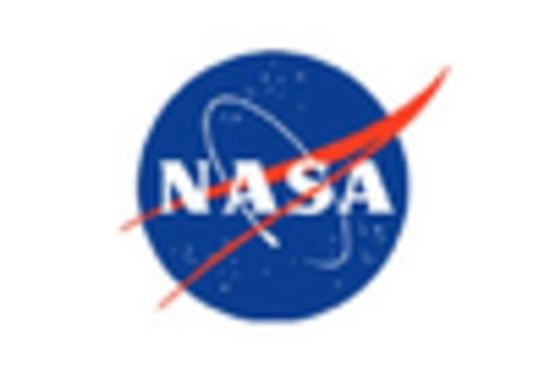Emergence of New Space Startups
The rise of new space startups is reshaping the landscape of the Space On Board Computing Platform Market. These startups are often agile and innovative, focusing on niche applications and novel technologies. Their entry into the market fosters competition and drives advancements in on-board computing solutions. Many of these companies are developing specialized platforms tailored for specific missions, such as satellite servicing or in-orbit manufacturing. This diversification of offerings is likely to stimulate growth in the market, as traditional aerospace companies may seek partnerships or acquisitions to enhance their technological capabilities. The dynamic nature of this startup ecosystem is expected to contribute significantly to the evolution of the Space On Board Computing Platform Market.
Growing Satellite Constellations
The proliferation of satellite constellations, particularly for communication and Earth observation, is a key driver in the Space On Board Computing Platform Market. As companies and governments invest in deploying large numbers of small satellites, the demand for efficient on-board computing systems increases. These systems are essential for processing data in real-time, managing communications, and ensuring operational efficiency. According to recent estimates, the number of satellites in orbit is expected to reach over 60,000 by 2030, necessitating advanced computing platforms to handle the increased data flow and operational complexity. This trend indicates a robust growth trajectory for the Space On Board Computing Platform Market, as stakeholders seek to enhance their capabilities in satellite operations.
Advancements in Artificial Intelligence
The integration of artificial intelligence (AI) into space systems is transforming the Space On Board Computing Platform Market. AI technologies enable autonomous decision-making, data analysis, and predictive maintenance, which are crucial for modern space missions. As missions become more complex, the need for intelligent systems that can operate independently is paramount. The market for AI in space applications is projected to grow significantly, with estimates suggesting a compound annual growth rate of over 20% in the coming years. This growth is likely to drive demand for sophisticated on-board computing platforms that can support AI algorithms and processes, thereby enhancing mission success rates and operational efficiency.
Regulatory Support for Space Activities
Regulatory frameworks supporting space activities are increasingly influencing the Space On Board Computing Platform Market. Governments are recognizing the strategic importance of space and are establishing policies that encourage investment and innovation. For example, streamlined licensing processes and incentives for private sector participation are becoming more common. These supportive regulations facilitate the development and deployment of advanced on-board computing systems, as companies can operate with greater confidence in their investments. As regulatory environments continue to evolve, they are likely to create a more favorable landscape for the growth of the Space On Board Computing Platform Market, enabling stakeholders to capitalize on emerging opportunities.
Increased Investment in Space Exploration
The surge in investment for space exploration initiatives is a notable driver of the Space On Board Computing Platform Market. Governments and private entities are allocating substantial resources to explore Mars, the Moon, and beyond. This influx of funding is leading to the development of advanced on-board computing systems that can support long-duration missions and complex scientific experiments. For instance, NASA's Artemis program aims to return humans to the Moon by 2024, necessitating cutting-edge computing solutions for navigation, communication, and data processing. The anticipated growth in exploration missions is expected to create a robust demand for innovative computing platforms, thereby propelling the market forward.

















Leave a Comment